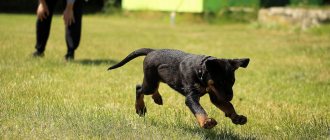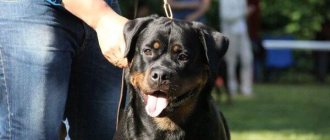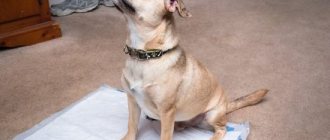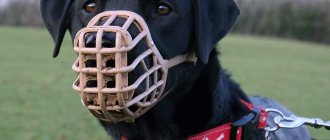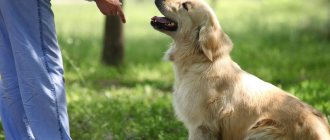In order for friendship with a pet to bring joy, you need to raise a dog from the first days of acquaintance. Before leash training your puppy, it is important to learn the advice of experienced owners. Dog handlers assure that the success of the training process depends on the character and age of the dog. The patience of the owner himself will also be important.
How to train a puppy to use a leash?
Why is this necessary?
A leash and collar are essential accessories for any domestic dog. Even those pets that rarely leave their home yard should be able to stay on a harness.
When you need a leash:
- A trip to the vet. A regular procedure requiring obedience and humility from the animal.
- Walking and moving in crowded places. The safety of others is paramount.
- Traveling on public transport. Animals will not be allowed on the bus without a muzzle and leash.
- Control of “unbalanced” individuals. Every dog, regardless of gender, has periods when it is ready to give up everything and run away to adventure.
- Visiting exhibitions where the animal's skills are assessed. Walking on a leash is one of the assessment categories.
Walking a Basset Hound on a Leash
Regardless of whether the pet will travel and stroll through city squares, the law obliges the owner to buy a leash and also teach the animal to behave in a restrained manner.
Why is it important
During walks, the owner must fully control his pet: the dog may run out onto the roadway, encounter aggressive animals, or be frightened by loud sounds and run away. In addition, representatives of large breeds can cause inconvenience to the people around them; walking them without a muzzle and a leash will result in a fine.
An untrained dog may react aggressively to new accessories: the collar will cause discomfort on the neck at first, and the leash will make it impossible to go wherever it wants, so you need to gradually accustom dogs to a leash.
Rules for first acquaintance
The list of necessary things for a puppy includes a bowl, toys, a brush, a bed and other small items. And if the dog remembers the feeding place with great pleasure, then getting to know the leash will most likely be difficult. To speed up the process, you should choose the right ammunition that does not cause inconvenience to either the animal or its owner. The animal’s first acquaintance with a new object is also important.
What did the owner come up with this time?
Getting used to the collar occurs gradually. Multicolored ribbons are placed around the necks of newborn puppies to distinguish the babies. Later the threads are replaced by light collars. But acquaintance with a leash occurs at a more conscious age, which leads to difficulties.
There are general rules that allow you to choose the right accessory for any pet, regardless of its breed.
Rules for selecting ammunition:
- As the puppy grows, you will need to change sets, so the first leash should be as “childish” as possible. A prerequisite is softness and natural materials. The harness should not rub your neck or put pressure on you.
- The first accessory should be short. You should not immediately purchase heavy leather products and roulette leashes. The first harness should be no longer than 1.5 meters.
- Before use, it is better to “ventilate” a new harness by leaving it in the apartment for several days. When foreign odors disappear, it will be easier for the puppy to perceive the new object.
- Introducing your pet to an unfamiliar thing should happen gradually. You can let the puppy sniff the object.
The first leashes and collars with external spikes were invented in Ancient Greece. This design made it possible to save the dog’s neck from wolf bites.
FAQ
How to stop a dog from chewing on a leash?
To wean your animal from this bad habit, you can smear the strap with a substance that is unpleasant for the animal: salt, pepper, etc. The dog’s taste buds will receive a negative signal, and he will no longer chew on the device.
Why does a dog not like a leash and what to do about it?
The animal does not like the leash because the owner did not properly accustom him to the device, the training was irregular or was not supported by treats. Therefore, stable connections between training and treats were not developed.
Start date
Accustoming a puppy to a collar is not difficult. On the very first day, the dog will get used to the new object, and soon he will begin to consider it his property. With a leash, things are more complicated. Rarely will a cub enjoy being on a leash. Therefore, when training, both the puppy and its owner will need a reserve of patience.
A puppy is a creature woven with emotions. His behavior is based on sensations and reactions to the world around him. This is why it is so difficult to train a pet to walk on a leash - an inquisitive creature resists the restriction of freedom.
Freedom is above all
Any education should be based on positive associations. It is important not to cause negative emotions in your pet associated with a new item. The first training sessions can be done in game mode.
How to leash train a puppy:
- You can start training as soon as your pet is 1.5-2 months old. Earlier lessons will not give results, and education at a later age will be complicated by a stronger character.
- The first lessons can be carried out when the baby stops showing increased interest in the new thing. He must also get used to the collar. Only after this can a leash be attached to it.
- The debut fitting lasts only a few minutes. At this time, it is important to engage your pet in play. However, the dog should not play with the harness.
Getting used to it will not come immediately. It is important to spend some time gradually increasing the time your pet is in the harness.
Tips for leash training a dog from breeders and dog trainers
When teaching your pets to use a leash, you should follow these tips:
- Owners can do everything right, but it happens that the pet still refuses to wear a leash, pulls it and bites it. In this case, breeders recommend starting training with tape or lace, which are made of softer material, which is why they are easier to get used to and cause less inconvenience. First, you can take a short cord and tie it to the collar. Once your dog is comfortable with the new accessory, you can use a longer cord.
- Pets love to chew on the leash, so you can’t leave it unattended. You should not leave an animal unattended with a leash because its end may get tangled in bushes or get under a stone and the dog will be seriously injured.
- If the dog starts to take off the leash, you should not help it, it will be perceived as encouragement and in the future it will start doing this all the time. It must be removed strictly after the animal has forgotten about it.
HOW TO CORRECTLY TRANSPORT A DOG ON A RUSSIAN RAILWAYS TRAIN IN 2022
WHAT NAME SHOULD YOU CHOOSE FOR YOUR DOG?
HOW TO TRAIN A DOG SO THAT IT STOP PEES AT HOME?
First home lessons
It is best to start learning in a familiar environment. At home, the puppy will not be frightened or distracted, which will help build positive associations. When the pet learns to behave confidently, the lessons can be reinforced on the street.
The first collar should not be heavy. The baby will not be happy with the accessory “for growth”. Such an item will be heavy and impractical. It is best to purchase a nylon strap with lightweight plastic buckles. By adjusting the width, secure the collar so that it cannot slip off over your head.
The right leash is the key to success
The first use of the leash for its intended purpose should only last a few minutes. During this time, it is important to hold the harness so that the puppy does not pay attention to it. You can talk to him, play, but do not focus on the “servitude” position. You cannot pull, pull or dangle the leash. It should hang freely.
Until the moment when the puppy discovers discomfort, the harness should be removed. The next lesson will last a few minutes longer.
The shorter and more frequent the lessons, the faster the puppy will get used to the new object. However, you shouldn't bother him. Wearing a harness several times a day can create a lasting negative association in your dog.
Over time, the duration of home workouts will reach 20 minutes. After this, you can start short walks around the apartment. It is important to train the dog to walk in the direction indicated by the owner.
The first trips will most likely be adjusted by a naughty puppy. Simple ways will help teach your pet to listen to its owner.
There are two methods to teach a puppy to follow its owner. This is a loyal method and a tough technique. Each of them has its own pros and cons.
Loyal method
This method will require maximum patience from the owner, but will maintain a trusting relationship with the pet. To work through it, small treats will be useful.
Weasel is the basis of training
Step by step method:
- The puppy is called by name and a leash is attached to the collar. After petting the dog, they begin to step forward. Most likely, the dog will quickly lose interest in what is happening and rush in the other direction.
- As soon as the leash tape becomes taut, you should stop. The dog must associate its behavior with the movements of the person. As soon as the puppy pulls on the harness, it becomes more difficult to walk - the owner stops.
- It is important to let your dog know that walking slowly is more effective than running.
- Every time the leash is pulled and the owner stops, you need to wait until the dog looks at the owner. A puppy that stops is rewarded with a treat.
- After a tasty prize, the trajectory of movement is changed. After a few lessons, the puppy will understand that it is not profitable to break away. Gradually, the treat is replaced with praise - the dog is told that he did well and is petted.
Some puppies react dramatically to an unfamiliar object. Once in a harness, pets lie down, sit down, or try to slip out of the “trap.” This behavior is quite natural. You should not punish the puppy for this. He needs to be distracted by playing and tricked into getting up. The technique is suitable for small puppies. For animals older than 4 months, a different method is used.
The loyal method is based on trust
The hard way
The method is based on simple conditioned reflexes. Every time the puppy tries to run about his business, he is sharply pulled back. It is enough to slightly pull the harness so that the dog feels a tug, but does not experience pain.
While running away, the puppy will encounter the same effect. Running hurts. After a few lessons, the pet will be able to hold on to the sagging harness without pulling on it.
For puppies over 5 months of age, Parfors can be used. A special collar with rounded teeth does not cut into the skin, but causes some discomfort, facilitating the assimilation of the command.
Regardless of the method chosen, it is important not to overwhelm your dog with the routine. Monotonous walking at your feet can have the opposite effect, provoking rebellion. 30-40 steps are enough to understand whether the dog is paying attention to the owner’s actions. It is important that there is trusting contact between the owner and the dog at the time of training. If the puppy is afraid of or does not trust a person, the training will take many weeks.
Interaction between owner and pet
How to choose the right leash
The type of suitable collar that will be needed for walking an animal depends on the size of the individual and the structural features of the head/neck. It may be necessary to use a backstrap or muzzle strap to walk the animal. Remember that a dog should only wear a collar under the supervision of its owner. If the dog is left alone in the room even for a short time, it is recommended to remove the collar from the neck to avoid unexpected injuries or suffocation of the animal.
Let's look at the most suitable types of dog collars:
The standard dog leash is most commonly used by dog owners. Durable, strong, with chrome rings and beautiful ornaments. You can choose any color. Not suitable for breeds with a smooth neck and a small head (Chihuahua) because the animal can easily slip out.
A beautiful collar made of artificial leather, with a luxurious decoration of rhinestones, will be convenient for walking with a Spitz or Pekingese for short distances, in the yard or a nearby park.
Harness Collar – Great for small breeds. Prevents airway damage if the puppy pulls on the leash. The collar prevents miniature breeds from slipping out of the strap.
With a double loop, this is an excellent device for dogs that have a bad habit of pulling on the reins. This is a double loop collar. When your four-legged friend pulls on the reins, the noose around his neck tightens, but does not choke him, just causes him discomfort.
A tape leash with a multibox for storing dog treats is convenient for an animal of any size. The product is distinguished by a durable body and a convenient chrome-plated clasp. Reflective elements allow you to see the dog in the twilight. The unique automatic winding system allows the owner not to worry about winding the strap in time, rather than picking it up from the ground.
A plastic device with a push-button length lock allows you to fix the required perimeter of the animal's walking.
The main thing to remember when choosing a collar is that the device is strong enough so that the strap does not break if it is pulled. The width of the belt must correspond to the parameters of the owner’s hand. A narrow strap can simply slip out of the owner's large hands if too much tension is applied.
To make sure that the dog has already developed the habit of wearing a collar, you need to repeat the training several times in different places.
Teaching a puppy commands
When the puppy stops tearing up, you can start teaching commands. The commands for walking on a leash are simple and won't require much effort.
Near
When walking a dog down the street, the owner should not reprimand or reward the dog for being a polite presence. The use of tasty prizes is permissible only at the initial stage of training. Later, the pet must listen to verbal orders and not expect a reward for following them.
Step-by-step training for the “Nearby” command:
- The dog is seated at the left leg. In the right hand they hold a leash and a treat.
- Having given the command “near”, they begin to move, holding the harness in a free position.
- The puppy should not be allowed to run ahead of its owner. All attempts to pull on the leash must be stopped. The dog must copy the pace of the person.
- All actions of the puppy are voiced in an appropriate tone. Correct execution is marked by the word “good” and the repetition of the word “near.”
When the puppy has covered the measured distance, they give him a reward and play with him. For one walk, 2-3 repetitions are enough.
Team "Nearby"
To me
The command will come in handy during a walk, when fastening the leash is urgently needed. Such an order will also help in organizing walks without a leash. Teaching a puppy to come when asked is not difficult. It is important that at the time of teaching the command the dog responds to its name.
During a walk, the pet is called to you, combining the nickname and the command “come to me” in the order. When the puppy runs up, he is praised and encouraged. After a few correct repetitions, feeding is followed by attaching to the leash. It is important to create a positive association in the puppy not only with the name, but also with the entire process. Gradually, rewards are given less often, while continuing to praise the pet.
Following the command “Come to me”, I rush to the call
You can read more about puppy training here.
On a walk
After walking on a leash has been practiced at home, you can go outside. It is best to choose a sports ground, park or wasteland. The main thing is that there are no other dogs, crowds of people, and especially cats around.
Only after making sure that there is no “irritant” nearby, fasten the leash to the collar, and start training walking together and the “near” command. Don't forget to reward your puppy's efforts with treats.
Some dogs get used to this type of walking quickly, others will take longer. Only after the commands have been worked out can you go straight out of the house with a leash.
Teaching an adult dog
Teaching commands to a puppy is easier than taming an adult animal. Often there is a need to teach a dog to walk on a leash that has lived in an enclosure or kennel for a long time. The principles of training in this case will be somewhat different from those for “toddlers.” While a small puppy's attention is completely focused on the owner, an adult pet will be more independent. A mature dog can react completely unpredictably to restriction of freedom. It is better to start training with a long leash. It is optimal if its length exceeds 5 meters.
It is better to do education in a deserted, quiet place. The first walks will be under the command of the dog. If she behaves adequately and does not try to escape, you can let her “walk” her owner. The harness should hang freely, giving the animal the illusion of freedom.
When the dog gets used to the presence of the tape, the distance to the owner can be gradually reduced. Most adult animals are reluctant to follow a person. While walking, they lag behind or pull on a short leash. In this case, you can use tasty rewards, attracting the dog’s attention to the treat. You should keep the prize in sight, each time drawing the animal's attention to the palm with food. If a dog is blocking the road, you cannot give it a treat. Adult pets can withstand longer training sessions. The lesson can last up to 30 minutes. However, at the first signs of fatigue, the dog should be released to play.
Long leash as an illusion of freedom
The role of tasty rewards
During the training process, the owner will need considerable patience. Raising a pet is based on trust and affection. A tasty prize for the dog will help reinforce your kind words. Any small treat that will fit in the palm of your hand and will not stain it will be suitable as a reward. You can use dry food. It is advisable to use food that is not available to the dog in everyday life. This will create the impression of a particularly attractive reward.
Don't rely too much on feeding tricks. By generously rewarding the dog for each command it completes, you can turn the animal into Pavlov's dog. The result of the orders will be increased appetite and incorrect execution of tasks.
The dog should not receive a prize if it performed the command incorrectly. Only perfect actions can be rewarded. If the puppy is tired, you can distract him with a toy, rather than with a portion of food that you don’t want to return to your pocket. When disobedient, it is important not to raise your tone, but to make it stricter. You can scare a puppy by screaming, but you won't be able to train him.
Dog training
Rules for the owner
In order for the training to give maximum results, not only the puppy, but also its owner will have to follow the rules. Dog handlers recommend that the owner follow these tips:
- For training, choose places that are familiar to the animal. It is advisable that nothing distracts him.
- If training takes place at home, you should limit the number of household members present.
- If the puppy is hyperactive, it is better to exercise with him after a long walk.
- You cannot move on to a new stage of training until the previous one has been mastered.
- A leash should not be a tool of punishment. Otherwise, it will cause fear in the trainee and make training difficult.
- The duration of one lesson should not exceed 15 minutes. After 10 minutes of work, the puppy will get tired, so the intensity of the training should be reduced.
When training a dog, it is important to follow the rules and also avoid common mistakes.
How long should a dog leash be?
What not to do
Inexperienced owners often make mistakes. Dog trainers have created a list of common mistakes when trying to introduce a dog to a leash.
Common mistakes:
- The puppy should not play with the equipment. This also applies to the rest period. The leash should be kept out of reach of your pet.
- When putting on the equipment, the puppy should not be overexcited. If he gets too played, it is better to postpone the procedure.
- While getting used to the collar, you should not leave the puppy alone with the new item. You can play with your pet or just watch him.
- If the dog does not want to go voluntarily, you should not pull on the harness. Rewards should only be positive.
- Don't be too strict about your puppy's desire to play. Long workouts exhaust him, so breaks from work are necessary.
- At an early age, it is better not to use the “harness” leash model. Pressure on the spine can lead to abnormal skeletal development. A regular strap attached to the collar would be optimal.
- Collars, shockers and other strict devices should not be used for ethical reasons.
Dog protest
Choosing a Collar
The choice of collar is of great importance. Keep in mind that the dog will grow, and for the first lessons there is no need to choose expensive, special equipment. The most comfortable will be a flat and lightweight collar that will not cause discomfort.
Avoid chain-shaped collars; a small puppy will most likely not want to wear one, because hair fibers getting into the chain links cause considerable discomfort.
If the dog is categorical
It happens that the owner has spent more than one week training the pet, but the dog still refuses to walk on a leash. Often the cause of the problem is negative emotions experienced by the animal previously.
Table 1. Possible causes of dog protest.
| Cause | Dog behavior |
| Discomfort | Perhaps the collar or parforce is chosen incorrectly. Feeling suffocated, the dog is unlikely to obey unconditionally. This is at odds with her instinct of self-preservation. |
| Spoiled | If you allow your puppy to play with the equipment, you should not be surprised at subsequent disobedience. There is only one way out of this situation - buying a new, completely different leash model. |
| Fright | The owner could not restrain himself and spanked the dog with a harness. The dog will remember such a gesture for a long time. It’s easy to check whether your pet is afraid of ammunition. It is enough to hit the palm of your hand with the strap and watch the dog’s reaction. If your pet bends its ears, the harness will have to be replaced. |
| Refusal | If buying a new leash does not help, you can temporarily use a special vest for puppies. It is not necessary to remove the collar while wearing it. |
A puppy is a small child. He doesn't understand the word "must". Therefore, when going for a walk, it is important to allow him to frolic to his heart's content. When the baby runs around and is ready to interact, you can start training.
Video - How to train a puppy to use a leash
Basic mistakes
If your puppy is constantly playing around, getting distracted, and not listening to you, then you may have made the following mistakes.
- They were allowed to play with a leash. Now the dog treats him like a toy and doesn’t take him seriously. In this case, it is better to buy a new accessory.
- They hit or waved the leash. This makes the puppy afraid or hostile towards him. In this situation, the leash also needs to be changed.
- They pulled the leash when the pet walked in the other direction. Over time, the dog got used to the pressure on his neck and for him it became a normal sensation.
- They shouted and scolded the animal during training. The dog began to perceive walks and training with fear. Smoothly change tactics, making it clear to the puppy that you will not offend him.
- They were loyal to pampering. The puppy sensed your weakness and is now trying to take on the role of leader. To change the situation, start stopping any disobedience.
- The training dragged on for several hours. Monotonous exercise tires dogs. Reduce your workout time to 20 minutes.
- We used a roulette leash. The dog is used to the feeling of tension. Replace with a regular leash.
- They chose the wrong collar size or tightened it too tightly, so the dog was constantly experiencing discomfort. Loosen or replace the accessory.
Most errors can be easily corrected. Work through them, and your pet will happily start walking on a leash, unconditionally following all your commands.
Selection of ammunition
There are many leash models. Each of them has its pros and cons. Experienced owners know when to use each of them. The following information will help novice dog owners:
Table 2. Types and characteristics of leashes.
| Leash type | View | Characteristic | Note |
| Roulette | Tape |
|
|
| Corded | |||
| Chain | Leash - chain with handle |
|
|
| Ringovka | Show ring with ring |
|
|
| Harness | Harness - vest |
|
|
| Lead leash | From tarpaulin |
|
|
| Leather |
| ||
| From sling with latex | Synthetic sling is a durable and practical option. |
An ideal option for a first leash would be a lightweight synthetic harness. The less she reminds the dog of herself, the faster the animal will get used to her presence.
A good leash and pleases the soul
Manufacturers and prices
When choosing ammunition for your quadruple friend, it is important to find a quality product that meets all the requirements of both the owner and the animal. However, the first leash will soon have to be replaced with an “adult” model, so when buying debut equipment, it is important not to overpay, but to purchase a reliable product.
The products of the Italian company Ferplast have proven themselves to be excellent. It makes sense to buy products from the German company Flexi. Any model of leash can be found in the assortment of the Dutch brand Roller.
Flexi products
Driver leashes
The advantage of a simple leash is the maneuverability when controlling the dog. The disadvantage of the model is the need to wrap the free end around the hand or hold it with the other hand. The chain-driver can injure the owner’s hand when working with a large dog. The most budget leashes cost about 200 rubles. Prices for more durable models start at 600 rubles.
Roulette
A convenient option for small and medium breeds. There are two types of tape measures - cord and tape. Corded options are suitable for small pets. It is better to walk dogs weighing more than 30 kg on a tape leash. The advantage of a tape measure is convenient control of the length of the leash. A significant drawback of the model is the risk of the mechanism breaking at the most inopportune moment. Prices for leashes and roulettes start from 800 rubles. A higher quality product costs over 1 thousand rubles.
Ringovka
Show rings are usually used at shows and other events where complete control over the dog is required. The advantage of the noose is the accelerated training of the animal. However, it is carried out on the basis of the negative experience of the puppy, so such equipment is rarely used for training pets. The disadvantage of ringovka is that it cannot be used on small breeds. The simplest model can be purchased for 150 rubles. More thoughtful designs made from high-quality material are more expensive - from 1.5 thousand rubles.
Training a pet is a long process
Training a pet is a long process. To teach a puppy to walk on a leash, the owner will need patience, as well as high-quality equipment.
